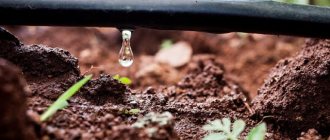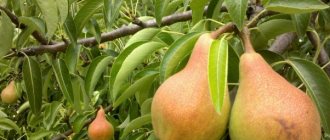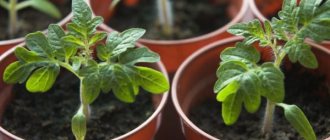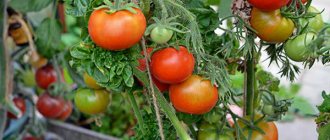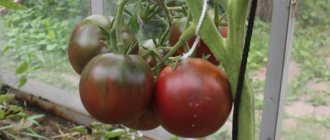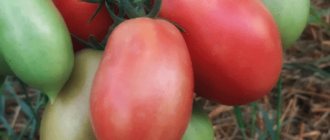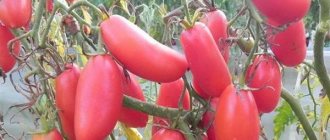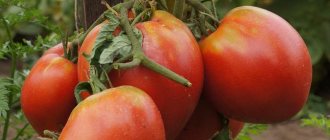Description of the tomato variety Lorraine beauty
The variety belongs to indeterminate self-pollinating crops. In southern latitudes it can be grown in open ground. But vegetable growers in the middle zone and the north will have to use greenhouses, otherwise the plant will not have time to produce a harvest.
Bushes
The tomato is not a standard variety, according to the characteristics and description, both red, orange, and yellow Lorraine beauty are distinguished by thin stems. The plant is highly branched, up to 2 m high, with a large number of leaves. Rich green plates of large sizes, with well-defined corrugation.
When growing, you will have to tie the crop to a support. On each Lorraine beauty tomato bush, at the 7-8 internode level, a flower cluster with 2-3 tomatoes is formed. As a rule, there are up to nine of them at their entire height.
Attention! Agricultural companies do not grow this variety, as they are not satisfied with the yield.
Fruits: taste, weight, size
The Lorraine beauty tomato has fruits of an unusual shape for Russians. They are slightly rounded and flattened. Already on the ovary the ribbing is clearly visible. If you look closely, the tomato is somewhat reminiscent of a flower whose petals are closed.
The fruits weigh from 200 to 450 g, although there are also giants weighing over 600 g; the skin is thick and dense. The color of the fruit depends on the variety; it can be yellow, orange, red or ruby-crimson. The pulp contains practically no dry matter and is moderately juicy. There are a lot of chambers without seeds, which allows you to stuff tomatoes like peppers.
Attention! The taste of the Lorraine beauty tomato is sour-sweet, but this indicator depends on the color. Yellow and orange fruits have more sugar than red ones.
Huge “flowers” can ripen on the Lorraine beauty tomato
Not only the color of the variety is responsible for the taste. In hot weather the fruits are sweeter. You can pick brown tomatoes; they ripen well and do not crack. They can be stored at home for a long time.
Transfer rules
With proper care you can get a rich harvest
In order for the sprouts to successfully take root in a new place, they should be hardened off. A week before transplanting, the seedlings are taken out into the fresh air, increasing the time spent outside daily.
Preparing the bed
Replanting is carried out in the middle or at the end of May, when the soil warms up to a temperature of 10-12°C.
The bed is cleared of the remains of last year's vegetation, sprinkled with humus (10 kg), wood ash (3 kg) and mineral preparations - 100 g of potassium salt and superphosphate. This amount is calculated for a plot of 1 m².
Technology of transplanting seedlings into the ground
This is a tall variety, so it requires a lot of space on the site - the optimal planting scheme is 50x60 cm. 4-5 bushes are planted per 1 m².
They dig holes, spill them with warm water, then lower the roots of the plants, cover them with soil without fertilizers and hill them up. Next to each bush, stakes are driven in, which will serve as further support.
After planting, the tomatoes are shaded to eliminate the risk of burning young foliage and stems. It is advisable to cover it with film at night, as the bushes may freeze.
Characteristics of tomato Lorraine beauty
According to the description and characteristics, the Lorraine beauty yellow tomato, like its other varieties, is best grown in protected ground in Russian conditions. Fruiting is long, the last tomatoes are harvested in the first ten days of October.
Advice! The better the tomato care, the more abundant the fruiting.
The Lorraine beauty tomato fruits vary in weight, but this does not detract from their originality
Tomato yield Lorraine beauty
The yield of the crop depends on compliance with the rules of care and weather conditions. If all standards are met and a favorable climate is created, approximately 3-4 kg of tomatoes are usually obtained from the bush. The first full fruits are harvested 125-130 days after germination.
Resistance to diseases and pests
If the Lorraine beauty tomato is grown in protected soil, then it gets sick less. After all, he has a weak immunity to blossom end rot and late blight. In wet weather, plants grown outdoors are severely affected by these diseases. This, in turn, reduces yields.
As for pests, they are the same as those of other representatives of the crop.
Methods of application
Beauty Lorraine tomatoes are not suitable for canning. They are consumed only fresh: in salads, slices. Stuffed tomatoes look interesting.
Yellow Lorraine beauty is no different in form and purpose from other varietal varieties
Advantages and disadvantages
The Lorraine beauty red tomato, like other varieties of the variety, is not particularly popular among Russian gardeners. Therefore, it is important to know the advantages and disadvantages of the species.
Those involved in culture note the following advantages:
- exotic fruit shape;
- long-term storage and possibility of transportation;
- do not crack when ripe;
- do not lose their taste and beneficial properties when ripening;
- pleasant taste;
- having good immunity.
The disadvantages are:
- dryish taste and lack of pulp in the fruits;
- restriction of culinary use;
- impossibility of canning;
- obvious dependence on weather conditions.
Advantages and disadvantages compared to other similar varieties
The Lorraine beauty tomato is grown infrequently, but is well described in the literature, and there are reviews about it from amateur gardeners. At the same time, both the advantages of the variety and its disadvantages are noted. The advantages include:
- original unusual appearance of tomatoes;
- long-term preservation and transportability of fruits;
- the ability of tomatoes to ripen during storage;
- good, for an ornamental variety, sweetish taste;
- resistance to a number of diseases.
Features of cultivation
The Lorraine beauty tomato with raspberry, orange or yellow fruits is not difficult to grow, according to reviews from gardeners. The agricultural technology for caring for nightshade crops is almost the same. Although there are differences. In particular, without regular fertilizing and watering it will not be possible to get a decent harvest.
Growing seedlings
Tomato varieties are grown through seedlings, otherwise the harvest cannot be harvested. Seeds are sown in April in the usual way. The seedlings do not require special care. So you can safely plant 3-5 bushes. Picking is carried out when 3-4 leaves have already formed on the plant; they are hardened off before planting in a permanent place.
After planting seedlings, it is useful to cover the roots with straw mulch.
Formation
Since the Lorraine beauty variety is tall and heavily leafy, it is best to grow it in one stem. It will be more convenient to remove stepsons and care for large fruits. In addition, you need to pick off the leaves from below, but no more than 3-5 at a time.
Warning! Work on removing shoots and leaves should be planned on a sunny morning so that the wounds dry quickly.
Garter
The bushes are tied to the cut after planting and during further care. It is best to install a strong stake, to which you then attach the stem and fruits. The fruits are very heavy, without a garter they can break off and damage the plant. Shoots need to be attached frequently, every 25-30 cm along the entire length of the stem.
Watering and fertilizing
Watering with cold water reduces crop yields and leads to diseases. Therefore, there should always be a filled container in the greenhouse. The Lorraine beauty does not tolerate drought, so you need to monitor the condition of the soil. At the same time, do not forget about ventilating the greenhouse. A layer of mulch will help retain moisture.
As for feeding, the tomato needs to be fed with nitrogen, potassium, and phosphorus. No less important for the variety are substances such as sulfur, zinc, manganese, and iron.
Many gardeners use nettle infusion to feed tomatoes.
Advice! As a preventive measure and feeding, it is useful to spray tomato bushes, including the Lorraine beauty, with an iodine solution (seven drops per bucket of water).
Planting and care
Watering tomatoes should be done once a week. If you water frequently, the bushes may wither and the roots will rot, which can lead to the death of the plants. When watering, you can add feeding solutions.
The Lorraine beauty tomato variety will give a good harvest, provided all the rules of care and maintenance are followed.
- Watering. The first moistening is carried out a week after transplanting the tomatoes into the garden bed. 1 liter of water is poured under each bush. The following procedure is carried out only after the top layer of soil has dried. The bushes experience the greatest need for moisture during the phase of budding and fruit filling, so the frequency of watering is increased to 2 times a week.
- After watering, the soil is loosened, the rows are weeded and weeds are removed. To eliminate the risk of the roots drying out, the bushes are mulched with garden soil a day after moistening.
- Tomato is responsive to organic and mineral fertilizers. The first feeding is carried out 7-10 days after transplanting the seedlings - add a solution of nitrophoska or urea - 1 tbsp. l. on a bucket of water. 200 ml of solution is poured under each bush. At the budding stage, tomatoes are spilled with liquid mineral fertilizer - 15 g of superphosphate and potassium salt per 10 liters of water. Consumption - 0.5 l per bush. The same composition is used to water the plants during the fruit-filling phase. Additionally, foliar nutrition of the bushes is carried out - irrigated with a solution of boric acid (0.2 g per liter of hot water 60°C). Plants can also be sprayed with iodine solution, which increases immunity against diseases and improves the quality of flowering and fruiting: 5 drops diluted with 3 liters of water. Foliar nutrition is carried out before flowering and a week after it.
- Forming a bush into two stems. The essence of the procedure is to isolate the central stem and the first stepson, which is formed under the first flower brush. All other stepsons 5-7 cm long must be removed. To avoid injury to the main stem, stepchildren must be removed with sterile scissors or a blade. The cut areas should be powdered with charcoal to avoid infection.
- As the main stem grows, it must be tied regularly to avoid the risk of breaking off under the weight of the fruit.
Pest and disease control
The Lorraine Beauty variety has good immunity. But gray, white or root rot cannot always be avoided. As a preventive measure, before planting seedlings, the soil should be watered with a solution of potassium permanganate or copper sulfate, and then the rows should be mulched.
To get rid of pests such as aphids, whiteflies, thrips, slugs and others, you can plant spicy plants in the greenhouse and spray them with an aqueous solution of ammonia from time to time.
Warning! Any chemicals to combat diseases or pests can be used before tomatoes begin to bloom.
Sowing, diving and planting in the ground
- The yar is carried out into the moist soil into the grooves made. The top of the caterpillar is covered with film or glass. If it is necessary to organize additional lighting for faster germination, special lamps are used.
- The air temperature should be approximately 25 degrees.
- After emergence of seedlings, the shelter can be removed.
- When 2-4 leaves are formed, the seedlings should be planted in separate pots, or cups.
- Before planting in the ground, plants must be hardened off. In this case, the seedlings are taken outside every day for a week. This is necessary so that they get used to the change in habitat and conditions) to adapt to the open air.
- Ready seedlings are planted in the ground or in a greenhouse at the end of May. The distance between plants should be at least 50 cm.
- A nutrient mixture of organic fertilizers should be added to the prepared holes. A ridge is installed next to the holes, where the bushes will be tied as they grow. To obtain larger fruits, the lower branches should be plucked. Ant. start off.
3 bushes are placed per 1 m2. The distance between the holes is 50-60 cm, the depth of the holes is 30 cm.
